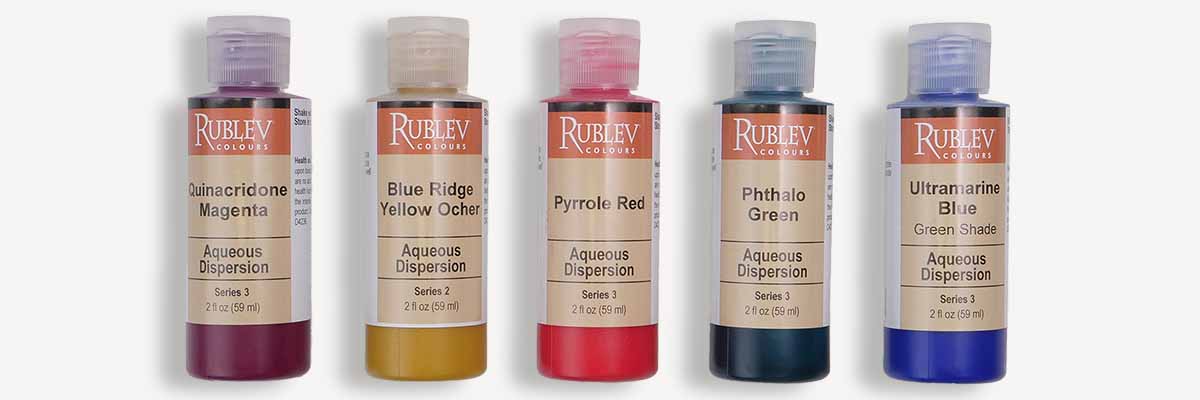Aqueous Pigments Dispersions Make Preparing Paint Easy
Natural Pigments introduces a new way of making traditional waterborne paint: Rublev Colours® Aqueous Dispersions. Aqueous dispersions are pigments dispersed in water ready to be mixed with water-based mediums. They make preparing waterborne paint easy; you don't hassle with powders, grinding, and calculating pigment-to-binder ratios. These dispersions are specially made for traditional painting mediums, such as egg, casein, fresco, watercolors, and distemper (glue tempera). They are also ideally suited for use with gesso for making toned grounds for drawing and painting.
Rublev Colours Aqueous Dispersions are highly concentrated, free-flowing, yet thick, stable liquids where pigment particles are suspended in water. Dispersions are produced by mixing dry pigments, water, and other ingredients.
Rublev Colours aqueous dispersion pigments are made by Natural Pigments. Please read our description of Rublev Colours Aqueous Pigment Dispersions for more information. For information about the permanence and composition of Rublev Colours Pigments, visit Pigments Composition and Permanence.
Visit our Swatch and Pigment guide for details on Rublev Colours Pigments images and where to find pigment information.
Complete Guide to Pigment Concentrates
Pigment concentrates (known as pigment dispersions) are single pigment pastes with as high as possible pigment content and as little as possible water. They are used in different ways to produce paints or tint mediums and grounds.
Why Should Artists Use Pigment Concentrates?
Water-based pigment concentrates or dispersions are a popular choice for many artists when it comes to creating their painting mediums. These pigments are suspended in a water-based solution, allowing for easy mixing and application to a variety of surfaces. There are several advantages to using water-based pigment concentrates or dispersions in artist painting mediums.
One of the primary advantages of pigment pastes is their ease of use. Because they are pre-dispersed, the pigments do not require additional grinding or mixing before they can be incorporated into a medium. This can save artists time and effort, as they do not need to spend as much time preparing their paint before they can begin painting. Additionally, pigment concentrates can be easily mixed with other materials, such as binders or thickeners, to create a custom medium that meets the artist's specific needs.
Another advantage of pigment pastes is that they are generally safer than powdered pigments. Many artists are concerned about the potential health risks of inhaling dust from powder pigments. Pigment pastes can be a good alternative for those who want to avoid these risks. Additionally, pigment concentrates are often easier to clean up and dispose of than other pigment forms, which can be important for artists who are conscious of their environmental impact.
Finally, pigment pastes offer a wide range of color options and can be used to create a variety of effects. Because they are pre-dispersed, the pigments are available in a wide range of colors and shades and can be easily mixed to create new colors or variations. Additionally, pigment concentrates can be used to create a variety of effects, such as transparent washes, opaque layers, or textured surfaces. This versatility makes pigment pastes a popular choice for many artists who want to experiment with different techniques and effects.
Pigment pastes offer a range of advantages for artists looking for an easy-to-use, safe, and versatile option for their painting mediums. With a wide range of color options and the ability to create various effects, pigment pastes can help artists achieve their desired results while minimizing potential health risks.
How to Use Pigment Concentrates in Artwork
There are many different ways to use pigment concentrates in your artwork. Let's consider three different ways.
Making Paint
Using pastes to make your own paint is an excellent choice for a wide range of colors and binders. This is especially true for tempera paint. Making paint from pigment concentrates is quicker than grinding powder pigments in water and then adding a binder, and it allows for greater flexibility in creating variations for different requirements.
Preparing Special Tints
When it comes to tinting, the final fine adjustment of color can be achieved by using pastes. These pastes make up a small percentage of the paint and have minimal impact on paint quality. Known as “nuancing”, this is a critical step in achieving the perfect hue and tint for your artwork.
Tinting Grounds
You no longer have to settle with white grounds for your painting. You can use a single pigment concentrate or a blend of pastes mixed with the desired ground or binder to make colored ground from deep tones to beautiful pastels. However, the more pigment pastes added to the ground, the more significant impact they have on the final quality of the ground. As a result, the quality of the pigment concentrates must be top-notch to achieve the desired outcome.
Using pigment pastes in tinting and paint-making can open up endless possibilities for achieving the perfect colors and paint for your artwork. As a painter, it is crucial to have a comprehensive understanding of these processes to achieve the best possible results. So, go forth with confidence and create magnificent works of art!
Frequently Asked Questions
What are pigment dispersions?
Pigment dispersions are dry pigments dispersed in a liquid that are usually stabilized with resins, dispersants, surfactants, or other additives to minimize flocculation, a phenomenon where pigment particles come out of suspension to sediment in the form of flocs or lumps.
What are dispersions in paint?
Dispersion is the principal paint-making stage. The purpose of dispersing pigments is to break up agglomerates and aggregates of dry pigment powder into individual or primary particles that remain stable and do not flocculate and sediment. Pigment dispersions do not require dispersing into the paint binder as they are ready to add to the liquid binder by simply stirring the dispersion into it.
How do you make pigment dispersions?
Pigment dispersions involve replacing air surrounding solid particles of the dry pigment powder with the liquid binder, separating the clumps of pigment particles so that they are uniformly distributed in the liquid. The dispersed particles must be separated and stabilized, or they will flocculate to form new clumps.
What are the properties of pigment dispersion?
The essential properties required for pigment dispersions are stability from sedimentation and flocculation, good viscosity, optimal opacity, and the highest tinting strength.
What is a pigment concentrate?
A pigment concentrate is another name for pigment dispersion, which is a mixture where pigments are dispersed in a liquid to a high concentration. This enhances color strength and stability in paints or coatings.
What is a color concentrate?
A color concentrate is designed to provide intense color when mixed with a base material, used in various industries to efficiently impart color without altering physical properties.
What are the types of pigment dispersion?
Pigment dispersions can be categorized based on their dispersing medium, such as aqueous (water-based) and non-aqueous (solvent-based), and by their application, including inks and paints.
What is the pigment dispersion method?
The pigment dispersion method involves dispersing pigments in a liquid medium to ensure uniform color and consistency, achieved through mechanical means like milling.
What is the dispersing agent for pigments?
A dispersing agent, or dispersant, is a chemical additive that stabilizes pigment particles in a dispersion, preventing clumping.
What is the role of surfactants in aqueous pigment dispersion?
Surfactants act as wetting agents, reducing surface tension and improving the wetting of pigment surfaces, aiding in even distribution.
What is the difference between a surfactant and a dispersant?
Surfactants reduce surface tension for better wetting, while dispersants prevent pigment particles from re-agglomerating, keeping them evenly distributed.
What is the difference between a wetting agent and a dispersing agent?
A wetting agent improves the initial wetting of particles by reducing surface tension, whereas a dispersing agent maintains uniform pigment distribution.
What is the function of a dispersing agent?
The function of a dispersing agent is to stabilize pigment particles within a dispersion, ensuring a uniform distribution of color.
Author: George O'Hanlon—See the Author's Biography














